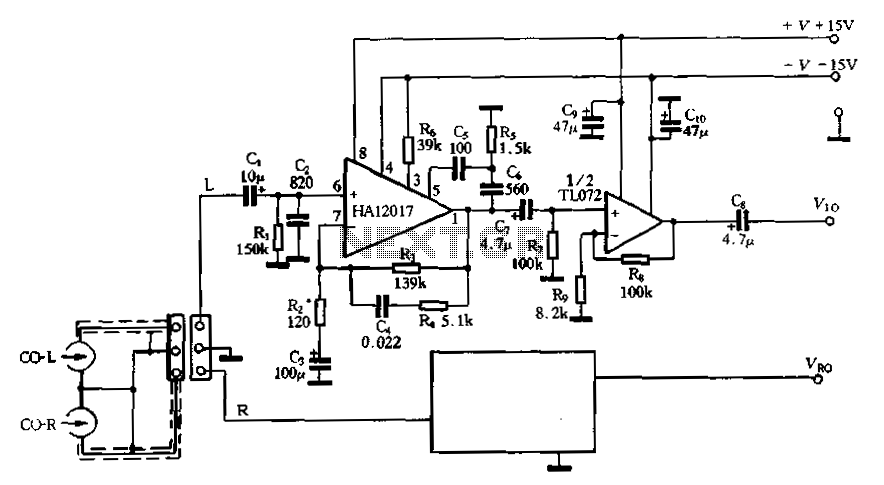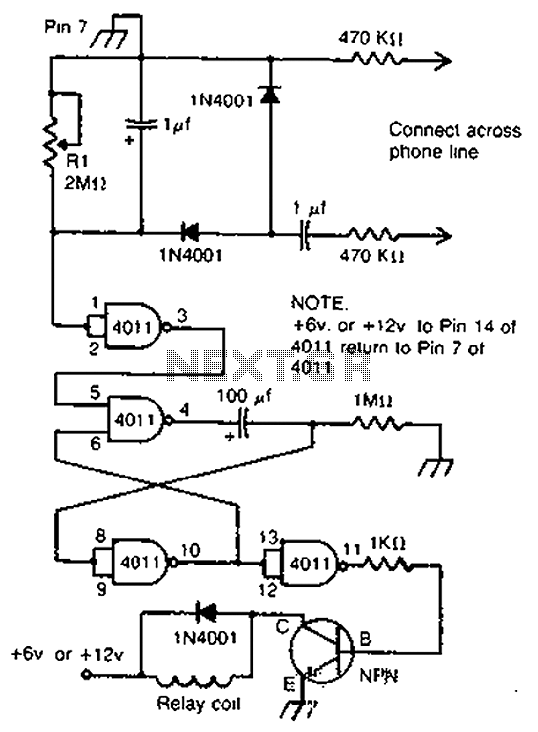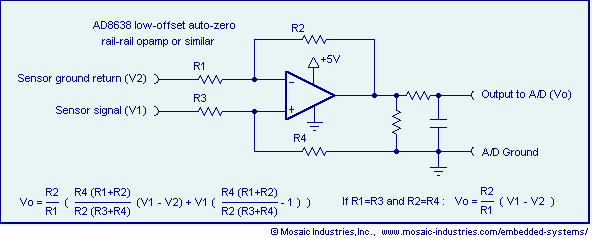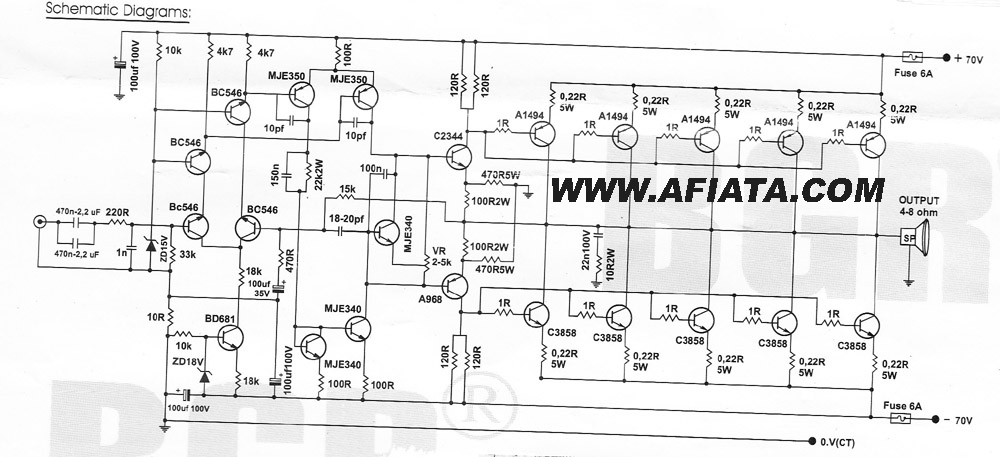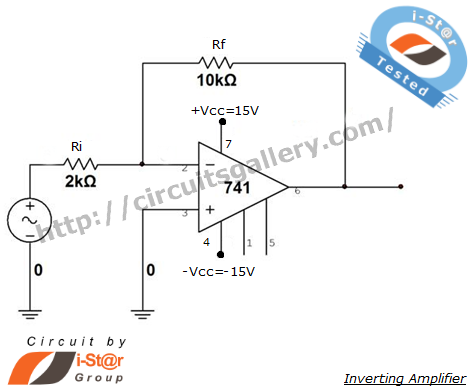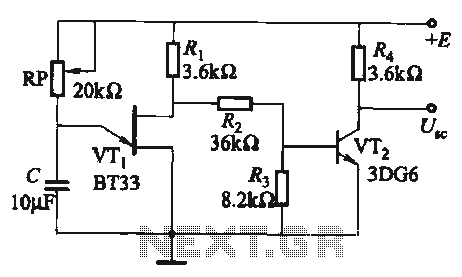
Using tap potentiometer loudness circuit
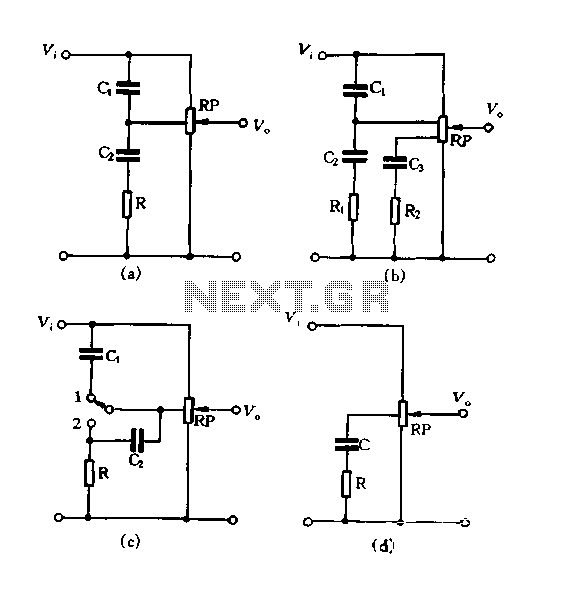
Figure 1.88 illustrates the loudness control circuit utilizing multiple taps on a potentiometer. In Figure (A), the connection is made between the tap and the potentiometer's input, along with the ground. An RC compensation network is employed, where the slide point near the rotary potentiometer tap (indicating a low volume) allows for enhanced bass response. This operates as follows: at low volumes, the input signal is significantly attenuated by the potentiometer, while the capacitive reactance varies with frequency, reducing the audio signal's rise rate at higher points. The capacitive element (cl) and the potentiometer tap direct a greatly attenuated signal to the output terminal, enhancing treble frequencies; simultaneously, the larger capacitance between the potentiometer tap and ground effectively attenuates high audio frequencies, thereby enhancing bass response. The maximum attenuation, which raises low treble frequencies, is determined by resistor R. Even at high volumes, when the potentiometer slider is positioned far from the tap, the RC element's influence maintains a flat frequency response in the output signal. The sound characteristics are influenced by the position of the potentiometer tap, where higher tap positions yield more pronounced early compensation effects, but with reduced amplification. Figures (b), (c), and (d) depict various other common compensation circuit configurations. Figure (b) features a double-tap circuit, which, although more complex, provides appropriate compensation across low, medium, and high volumes, yielding optimal results. Figure (c) includes a single-tap switch that, when set to position 1, functions similarly to circuit (a) for normal signal input; in position 2, the compensation network is disengaged for strong signal inputs. Figure (d) presents a simple single-tap design that only compensates for bass without treble compensation, making it suitable for general amplifiers.
The circuit described in Figure 1.88 is a sophisticated implementation of loudness control, commonly used in audio amplification systems to enhance the listening experience at lower volume levels. The design leverages the properties of resistors and capacitors to create a frequency-dependent response that compensates for the human ear's reduced sensitivity to lower sound levels, particularly in the bass and treble ranges.
The RC compensation network is crucial for adjusting the frequency response based on the potentiometer's position. When the potentiometer is set to lower volume levels, the input signal experiences significant attenuation due to the resistive divider formed by the potentiometer. The capacitive reactance, characterized by the capacitor's value (cl), plays a pivotal role in shaping the frequency response. At lower volumes, the high-frequency components are attenuated more than low frequencies, resulting in an enhanced bass response, which is essential for maintaining a balanced sound profile.
The configuration of the taps on the potentiometer allows for flexibility in sound tuning. The double-tapped circuit (Figure b) offers a more nuanced approach, providing tailored compensation across a broader range of volumes. This design ensures that listeners can enjoy a consistent audio experience, regardless of the volume setting. The single-tap switch (Figure c) adds functionality by allowing the user to bypass the compensation network for high signal levels, ensuring that the audio remains uncolored and true to the source material during loud playback.
In contrast, the simple single-tap design (Figure d) focuses solely on bass compensation, making it particularly useful in applications where treble enhancement is not desired. This design is beneficial in universal amplifiers that cater to a wide range of audio sources, allowing for straightforward integration without complex adjustments.
Overall, the described potentiometer control circuit exemplifies a well-engineered solution for dynamic audio environments, providing listeners with the ability to fine-tune their audio experience while maintaining fidelity across various listening conditions.Figure 1.88 using the loudness of several tapped the potentiometer control circuit. In FIG. (A), and between the tap and the input of the potentiometer and the land respectivel y, then A RC compensation network, when the slide point to the nearby rotary potentiometer tap (ie small volume), high, bass can be obtained make up. It works like this : In the small volume, the input signal through the RP partial pressure attenuation silver big, but cl capacitive reactance with frequency and reduce the rate of rise of the audio signal in a high- points can be by cl and tap the potential, sent directly to the output terminal, is greatly attenuated Tibetan small, that treble relatively be enhanced; connected to the potentiometer tap and the ground between the islands larger capacity, capable of the high audio attenuate the same time, that is, from relatively enhanced bass effect; the maximum attenuation (ie low treble sound relatively lift) by R determines the size.
Even at high volume, point to the upper end of the slide potentiometer, away from the tap position, it can not afford to make progress RC element effects, flat frequency response of the output signal. Such sound effects and potential of the control compensation circuit pumping head location of: tap positions higher compensation more early action, but the lift is reduced o Figure (b), (c) - (d) are several other commonly used form of compensation circuit.
Figure (b) is double-tapped, the circuit is more complex, but it was big, medium and small volume can give appropriate compensation, the best results. Figure (c) is a single tap changer type switch is set to 1 when the circuit (a), as applicable to normal signal input; when placed in the 2 position, the compensation network out of action for a strong signal input.
Figure (d) is a simple one-tap type, only compensation for bass, treble without compensation, and more for universal amplifiers.
The circuit described in Figure 1.88 is a sophisticated implementation of loudness control, commonly used in audio amplification systems to enhance the listening experience at lower volume levels. The design leverages the properties of resistors and capacitors to create a frequency-dependent response that compensates for the human ear's reduced sensitivity to lower sound levels, particularly in the bass and treble ranges.
The RC compensation network is crucial for adjusting the frequency response based on the potentiometer's position. When the potentiometer is set to lower volume levels, the input signal experiences significant attenuation due to the resistive divider formed by the potentiometer. The capacitive reactance, characterized by the capacitor's value (cl), plays a pivotal role in shaping the frequency response. At lower volumes, the high-frequency components are attenuated more than low frequencies, resulting in an enhanced bass response, which is essential for maintaining a balanced sound profile.
The configuration of the taps on the potentiometer allows for flexibility in sound tuning. The double-tapped circuit (Figure b) offers a more nuanced approach, providing tailored compensation across a broader range of volumes. This design ensures that listeners can enjoy a consistent audio experience, regardless of the volume setting. The single-tap switch (Figure c) adds functionality by allowing the user to bypass the compensation network for high signal levels, ensuring that the audio remains uncolored and true to the source material during loud playback.
In contrast, the simple single-tap design (Figure d) focuses solely on bass compensation, making it particularly useful in applications where treble enhancement is not desired. This design is beneficial in universal amplifiers that cater to a wide range of audio sources, allowing for straightforward integration without complex adjustments.
Overall, the described potentiometer control circuit exemplifies a well-engineered solution for dynamic audio environments, providing listeners with the ability to fine-tune their audio experience while maintaining fidelity across various listening conditions.Figure 1.88 using the loudness of several tapped the potentiometer control circuit. In FIG. (A), and between the tap and the input of the potentiometer and the land respectivel y, then A RC compensation network, when the slide point to the nearby rotary potentiometer tap (ie small volume), high, bass can be obtained make up. It works like this : In the small volume, the input signal through the RP partial pressure attenuation silver big, but cl capacitive reactance with frequency and reduce the rate of rise of the audio signal in a high- points can be by cl and tap the potential, sent directly to the output terminal, is greatly attenuated Tibetan small, that treble relatively be enhanced; connected to the potentiometer tap and the ground between the islands larger capacity, capable of the high audio attenuate the same time, that is, from relatively enhanced bass effect; the maximum attenuation (ie low treble sound relatively lift) by R determines the size.
Even at high volume, point to the upper end of the slide potentiometer, away from the tap position, it can not afford to make progress RC element effects, flat frequency response of the output signal. Such sound effects and potential of the control compensation circuit pumping head location of: tap positions higher compensation more early action, but the lift is reduced o Figure (b), (c) - (d) are several other commonly used form of compensation circuit.
Figure (b) is double-tapped, the circuit is more complex, but it was big, medium and small volume can give appropriate compensation, the best results. Figure (c) is a single tap changer type switch is set to 1 when the circuit (a), as applicable to normal signal input; when placed in the 2 position, the compensation network out of action for a strong signal input.
Figure (d) is a simple one-tap type, only compensation for bass, treble without compensation, and more for universal amplifiers.
